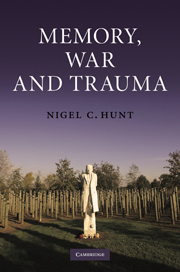Book contents
- Frontmatter
- Contents
- Preface
- 1 Background and purpose
- 2 Historical perspective
- 3 Methods and ethics
- 4 Current theory: post-traumatic stress disorder
- 5 Approaches to understanding trauma
- 6 Positive outcomes of traumatic experiences
- 7 Memory and history
- 8 Personal narrative and social discourse
- 9 Illustrating narrative as a scientific technique: the role of social support
- 10 Ageing, trauma and memory
- 11 Literature and trauma
- 12 Memorialisation and commemoration
- 13 Battlefield tours
- 14 Conclusions and future directions
- References
- Index
4 - Current theory: post-traumatic stress disorder
Published online by Cambridge University Press: 05 June 2012
- Frontmatter
- Contents
- Preface
- 1 Background and purpose
- 2 Historical perspective
- 3 Methods and ethics
- 4 Current theory: post-traumatic stress disorder
- 5 Approaches to understanding trauma
- 6 Positive outcomes of traumatic experiences
- 7 Memory and history
- 8 Personal narrative and social discourse
- 9 Illustrating narrative as a scientific technique: the role of social support
- 10 Ageing, trauma and memory
- 11 Literature and trauma
- 12 Memorialisation and commemoration
- 13 Battlefield tours
- 14 Conclusions and future directions
- References
- Index
Summary
Introduction
This chapter focuses on our current understanding of war trauma. This is a rapidly changing area, and space does not permit a thorough coverage of all theories. Instead, the focus will be on the key constructs and the relationship between them. The area of war trauma is fascinating because it is an area within psychology that allows us to draw together the often disparate and contradictory perspectives, particularly psychoneurology, cognition, psychodynamics, behaviourism and social theory. The purpose of the chapter, then, is not to provide a full theoretical account of our understanding of war trauma, but to provide the scaffolding from which we can build that understanding. Chapter 7 focuses on memory, particularly traumatic memory. This chapter discusses the construct of post-traumatic stress disorder (PTSD), and associated comorbid disorders. PTSD is the main classification that is used in the diagnosis of war trauma, and it has been an effective heuristic, helping bring about many thousands of publications on the subject. While it is a popular diagnosis, and very useful for clinicians, there are some problems with it, and there is debate about the structure of the syndrome (its symptoms have been revised with each revision of the diagnostic classification system) and some question as to whether it should even be retained.
PTSD
As described in Chapter 2, the construct now known as PTSD has existed for many years under a variety of formulations and names, mainly relating to battle experience (battle fatigue, combat neurosis, etc.).
- Type
- Chapter
- Information
- Memory, War and Trauma , pp. 50 - 60Publisher: Cambridge University PressPrint publication year: 2010



